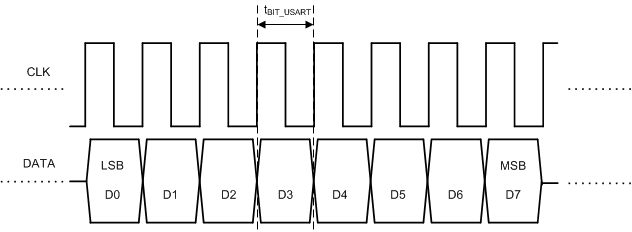SLASEJ4C April 2017 – February 2023 PGA460
PRODUCTION DATA
- 1 Features
- 2 Applications
- 3 Description
- 4 Revision History
- 5 Pin Configuration and Functions
-
6 Specifications
- 6.1 Absolute Maximum Ratings
- 6.2 ESD Ratings
- 6.3 Recommended Operating Conditions
- 6.4 Thermal Information
- 6.5 Internal Supply Regulators Characteristics
- 6.6 Transducer Driver Characteristics
- 6.7 Transducer Receiver Characteristics
- 6.8 Analog to Digital Converter Characteristics
- 6.9 Digital Signal Processing Characteristics
- 6.10 Temperature Sensor Characteristics
- 6.11 High-Voltage I/O Characteristics
- 6.12 Digital I/O Characteristics
- 6.13 EEPROM Characteristics
- 6.14 Timing Requirements
- 6.15 Switching Characteristics
- 6.16 Typical Characteristics
-
7 Detailed Description
- 7.1 Overview
- 7.2 Functional Block Diagram
- 7.3
Feature Description
- 7.3.1 Power-Supply Block
- 7.3.2 Burst Generation
- 7.3.3 Analog Front-End
- 7.3.4 Digital Signal Processing
- 7.3.5 System Diagnostics
- 7.3.6
Interface Description
- 7.3.6.1 Time-Command Interface
- 7.3.6.2
USART Interface
- 7.3.6.2.1 USART Asynchronous Mode
- 7.3.6.2.2 One-Wire UART Interface
- 7.3.6.2.3 Ultrasonic Object Detection Through UART Operations
- 7.3.6.3 In-System IO-Pin Interface Selection
- 7.3.7 Echo Data Dump
- 7.3.8 Low-Power Mode
- 7.3.9 Transducer Time and Temperature Decoupling
- 7.3.10 Memory CRC Calculation
- 7.3.11 Temperature Sensor and Temperature Data-Path
- 7.3.12 TEST Pin Functionality
- 7.4 Device Functional Modes
- 7.5 Programming
- 7.6 Register Maps
- 8 Application and Implementation
- 9 Device and Documentation Support
- 10Mechanical, Packaging, and Orderable Information
Package Options
Mechanical Data (Package|Pins)
- PW|16
Thermal pad, mechanical data (Package|Pins)
Orderable Information
7.3.6.2.1.8 USART Synchronous Mode
For fast (8 Mbps) communication between the controller MCU and the PGA460 device, a fast USART synchronous mode is implemented. This mode uses and is only available on the RXD and TXD pins and is also using the SCLK pin as a clock input for communication to the device. In this mode the USART interface acts as a serial-shift register with data set on the rising edge of the clock and sampled on the falling edge of the clock. Differently than the USART asynchronous mode, the synchronous mode communication frame does not include a start, stop, nor interfield wait bit which means that as soon as the data in one frame has completed, the next communication data frame follows immediately. USART Synchronous Mode is identical to a Serial Peripheral Interface (SPI) without a chip-select because the addressing is handled by the three-bit UART_ADDR value to enable up to eight devices on a single bus. #X210 shows the bit timing in synchronous mode and #X9809 shows the data flow for USART synchronous mode.
 Figure 7-28 USART Synchronous Interface Bit Timing
Figure 7-28 USART Synchronous Interface Bit Timing Figure 7-29 USART Synchronous Mode Data Flow
Figure 7-29 USART Synchronous Mode Data FlowAs shown in #X9809, each data frame is 8-bits long with little endian format (least significant bit [LSB] first). All other functionality of the USART synchronous mode aligns with the USART asynchronous mode. Muxing of the IO pin of the USART synchronous mode is not possible and the IO pin transceiver is disabled when the device is communicating through USART in the case when the IO_IF_SEL bit is set to 1.
The PGA460 device can communicate in USART synchronous mode immediately when a rising clock on the SCLK pin is detected. No activation or deactivation of this mode is available.
If this communication mode is not used, the SCLK pin should be connected to GND to prevent noise triggering the clock input.